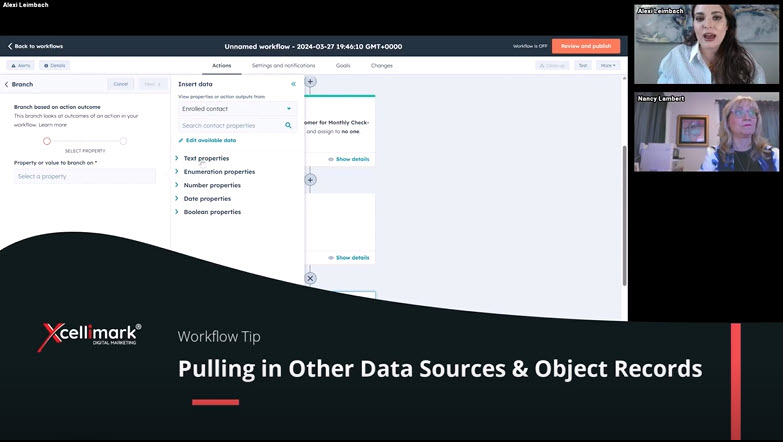HubSpot Workflow Tips | How to Pull In Data Sources and Object Records

This informative HubSpot training introduces a fresh approach to organizing property fields based on their type. The training provides insights on how to incorporate additional records or information from the CRM by modifying existing data sources.
Video Overview
- New way of organizing property fields: This video provides an overview of how property fields in a HubSpot workflow are now categorized by type, including text, number, date, or Boolean properties.
- Adding data sources from other records: The video demonstrates how users can easily incorporate data sources from various objects or records within the CRM, including tasks, companies, and deals. This expands access to a wider range of information and criteria for optimizing workflows.
- Using association labels to filter data sources: The video showcases how association labels can be utilized to filter data sources based on specific labels or activities. For instance, users have the option to retrieve only the primary company information or the most recently updated company.
How to Pull In Data Sources and Object Records
In the fifteenth part of our ‘How to HubSpot’ series, we’re examining HubSpot’s enhanced data organization within workflows. This new structure is not just a list of properties; it’s a categorized system that separates your text, number, date, and Boolean properties, making it easier to navigate and utilize the data you need.
When you’re looking to reference tasks and can’t find the overdue ones, it’s likely because your current data view is limited to contact information. To pull in additional records or information from the CRM, you’ll need to edit the available data.
By adding a new data source, you can access a wealth of information beyond the contact level.
For instance, if you’re looking to pull in the latest task created for a contact, you can now do so with ease. This is particularly useful when you want to reference the most recently created task, rather than just an updated one, ensuring that you’re working with the most up-to-date information.
If you encounter association labels while pulling in data sources, don’t worry. HubSpot provides the flexibility to pull in company information based on specific association labels, such as ‘primary company’. This feature is invaluable when dealing with contacts associated with multiple companies, allowing you to specify which company record you want to reference.
Whether you’re pulling in data by association label or activity, HubSpot’s organized approach to data sources streamlines the process, saving you time and enhancing the accuracy of your workflows.
Join us as we continue to explore the capabilities of the HubSpot CRM. At Xcellimark, we’re committed to helping you navigate the platform’s features, ensuring that your digital marketing strategies are as effective, efficient, and data-driven as possible.








